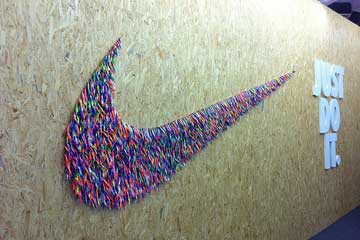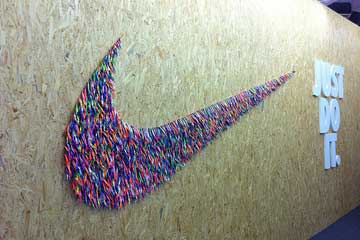*Positioning
Nike positioning claims values as its own distinctive traits

One of the most compelling brands in the world is undoubtedly Nike. The famous slogan ‘Just Do It’ and the iconic swoosh logo are known by everyone, but do you know where the brand comes from? Or why it’s so successful? We walk through the years of Nike’s positioning and explain what the future of positioning looks like. After reading, you’ll not only understand Nike’s strategy but also how to apply it yourself.
Nike positioning: podcast
In episode 5 of our podcast, we pit two famous sports brands against each other. It’s a fun way to look at the well-known Nike brand and a great addition to this article.
The company started as Blue Ribbon Sports in 1964 and was a distributor of the Japanese brand Onitsuka Tiger. For the first two years, employees sold shoes from the trunk of their car, but the company grew so fast that it soon opened two stores. It wasn’t until 1971, as the relationship with Onitsuka Tiger was ending and the company started selling its own shoes, that BRS launched the Nike brand and Swoosh logo. From 1976, the company really took off, launching its first ‘brand advertisement,’ a feature where no product was shown. Four years later, Nike had 50% of the American athletic shoe market! In the years that followed, the company grew into the massive multinational it is today.

Foto door Achim Hepp
Nike’s positioning has always been relatively straightforward. By sponsoring the most famous and appealing athletes and communicating exclusively at the brand level, Nike links its brand to the concepts of talent, perseverance (just do it), and excelling. An additional advantage of communicating at the brand level is that it allows for a wide range of products to be associated with the brand, as long as the brand values remain consistent. In addition to all conceivable sports equipment, Nike also sells ‘urban fashion’ and even electronics thanks to its partnership with Apple. The consistent and clear way of marketing and communication has been very profitable for the company. With a revenue of $24 billion, a profit of $3 billion, and 44,000 employees, the company is one of the largest in the world.
Nike Positioning in Danger
It was around 1990 that the company encountered problems. There was a lot of attention for the terrible working conditions of production employees, and the company was forced to publicly address this issue. In 1998, CEO Phil Knight even concluded that: “The Nike product has become synonymous with slave wages, forced overtime, and arbitrary abuse.” This severely damaged the brand’s image and had a huge impact on sales results. It wasn’t until 2005 that the real turnaround began, and nowadays, the company is even seen as a frontrunner in terms of openness and corporate governance. It now even wins awards for its climate-friendliness.
The secret behind this success is the hard lessons the brand learned in the bad years. Nike had to embrace every opportunity it got to influence public opinion; the brand was an early adopter of internet marketing, narrowcasting, multimedia campaigns, and community building. As early as 1997, Nike began data mining customer feedback via email, at a time when ‘the internet’ was still unknown to many. The company had to fight its way back into its customers’ good graces and has been doing so to this day. This strategy turned out to be so successful that it’s now the main pillar of its positioning. In recent years, it’s been much less about the Nike brand and much more about the customer or community Nike connects with. Instead of talking about its own brand, Nike nowadays talks mainly about the values its community stands for.
The conclusion of this story is that a strong positioning ensures recognizable brand values. Brand values that have changed little over the years. But that doesn’t mean the tools used and the way of communicating don’t change. Nike’s story proves that positioning at the execution level must evolve with time if a company is to remain successful. We think Nike is a great example of how a company uses the tools available at the time to reinforce its positioning over the years. Without really detracting from what it has stood for since the early years.